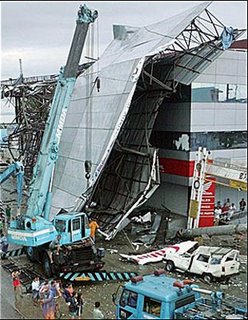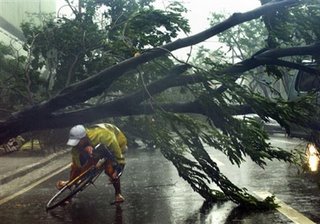Speech : Aftermath of the Storm
This is my speech project #9, which delivered at my TM club last night (10/12/06).
=======================================
Speech : Aftermath of the Storm
Do you remember this?
(Show pics …)
These pictures were taken two weeks ago when typhoon "Milenyo" (international name: “Xangsane”) hit the Philippines.
Milenyo shuts down Metro
Typhoon batters Metro Manila, Bicol
Strongest typhoon in 11 years
3 more weeks before full power
Stories, and more sad stories... :( I’m sure everyone here has heard or read of some sad stories related to the storm, but you know, the stories hit closer to home when it affects people we know.
Two friends of mine are originally from Bicol, and they still have family there. Of one friend, part of their roof covering their living room, was blown off during the height of the storm. The other friend? The only thing left of their home after the storm, was the floor! His mom, is still probably reeling, and crying her eyes out from losing their ancestral home. And understandably so.
Our laundry lady also had a sad story to tell. She tearfully related to me that her family doesn’t have a home anymore, as it was blown away by the typhoon. Right now, she and her 3 kids are living in the garage of another home, and saving up money to buy materials to build a new home.
While all this was playing out in the real world, I was in bed reading a book. My kids were downstairs playing board games, and when electricity went out, and the wind was howling so eerily and loudly, I decided to go downstairs and cuddle (take note, cuddle and NOT huddle) with my kids. It was like a vacation for us! Not having a radio, we knew little of the havoc typhoon "Milenyo" was unleashing that very moment. It was only much later, while watching the nightly news did we see the damage wrought on so many areas, that we truly realized how lucky we were...
We heard stories about people whose homes were damaged, people getting hurt, but what hurt most to hear, were how people died, or LOST their homes or loved ones…
If anything, what did this storm teach us?
First, it taught us that DISASTERS happen… Whether you live in the posh villages of Makati, or in the shanties around Metro Manila, disasters do happen, and CAN affect each one of us.
Second, it taught us that it pays to prepare. The time to fix that leaky roof was not during the storm but before the storm! You don’t go to the grocery to buy candles or flashlights during the blackout, do you?
Then lastly, it taught us that we need to move on after we are hit, no matter what the damage, because as they say, LIFE GOES ON…
And speaking of LIFE, natural disasters are not the only STORMS that we need to weather in life! Because aside from disasters wrought by nature, there are disasters wrought by emotional trials, such as illness, accident, loss.. All of which are results of living in an imperfect, broken world. Sooner or later, illness, accidents OR loss eventually touch our lives. These are the STORMS that we can NEVER really prepare for…
So what do we do when faced with emotional trials or storms? Personally, I feel that it is important to remember 3 things…
FIRST - When disaster knocks at your door, vent your grief. Man, woman, child, we all should let go of the thinking that crying is a sign of weakness. It is no secret that men compared to women, are prone to bottle feelings up and refuse to cry even when faced with the worst of situations. BUT tears wash the bitterness from within. They purge deep feelings of resentment from the walls of our hearts. So, yes, it is okay to cry.
SECOND - Refuse to be bitter. Stand up, brush the negativity off, pick up the pieces, and move on… I know that’s easier said than done. But remember the saying, whatever doesn’t kill us, will only make us stronger.
THIRD - Rely upon the Lord to be your strength. Nahum Chapter 1, Verse 7 states, “The LORD is good, a refuge in times of trouble. He cares for those who trust in him”. Another one of my favorite quotes is, “If GOD brings us to it, HE will bring us through it”. Truly, FAITH and prayer helps.
There's probably nothing that will prepare us for personal tragedies. But know and accept that these emotional storms caused by failures OR loss, can happen to anyone, at any time. We need to be strong enough to withstand them not just for ourselves, but for the sake of other people who care for us, and who rely on us. Knowing that should give us the necessary foundation to withstand ANY storm – whether brought on my nature, or by personal tragedy.
Remember, how we handle ourselves in the worst of situations will determine if the lives we lead is one of bitterness, or acceptance.
Good evening.
=======================================
Speech : Aftermath of the Storm
Do you remember this?
(Show pics …)
These pictures were taken two weeks ago when typhoon "Milenyo" (international name: “Xangsane”) hit the Philippines.
Milenyo shuts down Metro
Typhoon batters Metro Manila, Bicol
Strongest typhoon in 11 years
3 more weeks before full power
Stories, and more sad stories... :( I’m sure everyone here has heard or read of some sad stories related to the storm, but you know, the stories hit closer to home when it affects people we know.
Two friends of mine are originally from Bicol, and they still have family there. Of one friend, part of their roof covering their living room, was blown off during the height of the storm. The other friend? The only thing left of their home after the storm, was the floor! His mom, is still probably reeling, and crying her eyes out from losing their ancestral home. And understandably so.
Our laundry lady also had a sad story to tell. She tearfully related to me that her family doesn’t have a home anymore, as it was blown away by the typhoon. Right now, she and her 3 kids are living in the garage of another home, and saving up money to buy materials to build a new home.
While all this was playing out in the real world, I was in bed reading a book. My kids were downstairs playing board games, and when electricity went out, and the wind was howling so eerily and loudly, I decided to go downstairs and cuddle (take note, cuddle and NOT huddle) with my kids. It was like a vacation for us! Not having a radio, we knew little of the havoc typhoon "Milenyo" was unleashing that very moment. It was only much later, while watching the nightly news did we see the damage wrought on so many areas, that we truly realized how lucky we were...
We heard stories about people whose homes were damaged, people getting hurt, but what hurt most to hear, were how people died, or LOST their homes or loved ones…
If anything, what did this storm teach us?
First, it taught us that DISASTERS happen… Whether you live in the posh villages of Makati, or in the shanties around Metro Manila, disasters do happen, and CAN affect each one of us.
Second, it taught us that it pays to prepare. The time to fix that leaky roof was not during the storm but before the storm! You don’t go to the grocery to buy candles or flashlights during the blackout, do you?
Then lastly, it taught us that we need to move on after we are hit, no matter what the damage, because as they say, LIFE GOES ON…
And speaking of LIFE, natural disasters are not the only STORMS that we need to weather in life! Because aside from disasters wrought by nature, there are disasters wrought by emotional trials, such as illness, accident, loss.. All of which are results of living in an imperfect, broken world. Sooner or later, illness, accidents OR loss eventually touch our lives. These are the STORMS that we can NEVER really prepare for…
So what do we do when faced with emotional trials or storms? Personally, I feel that it is important to remember 3 things…
FIRST - When disaster knocks at your door, vent your grief. Man, woman, child, we all should let go of the thinking that crying is a sign of weakness. It is no secret that men compared to women, are prone to bottle feelings up and refuse to cry even when faced with the worst of situations. BUT tears wash the bitterness from within. They purge deep feelings of resentment from the walls of our hearts. So, yes, it is okay to cry.
SECOND - Refuse to be bitter. Stand up, brush the negativity off, pick up the pieces, and move on… I know that’s easier said than done. But remember the saying, whatever doesn’t kill us, will only make us stronger.
THIRD - Rely upon the Lord to be your strength. Nahum Chapter 1, Verse 7 states, “The LORD is good, a refuge in times of trouble. He cares for those who trust in him”. Another one of my favorite quotes is, “If GOD brings us to it, HE will bring us through it”. Truly, FAITH and prayer helps.
There's probably nothing that will prepare us for personal tragedies. But know and accept that these emotional storms caused by failures OR loss, can happen to anyone, at any time. We need to be strong enough to withstand them not just for ourselves, but for the sake of other people who care for us, and who rely on us. Knowing that should give us the necessary foundation to withstand ANY storm – whether brought on my nature, or by personal tragedy.
Remember, how we handle ourselves in the worst of situations will determine if the lives we lead is one of bitterness, or acceptance.
Good evening.





